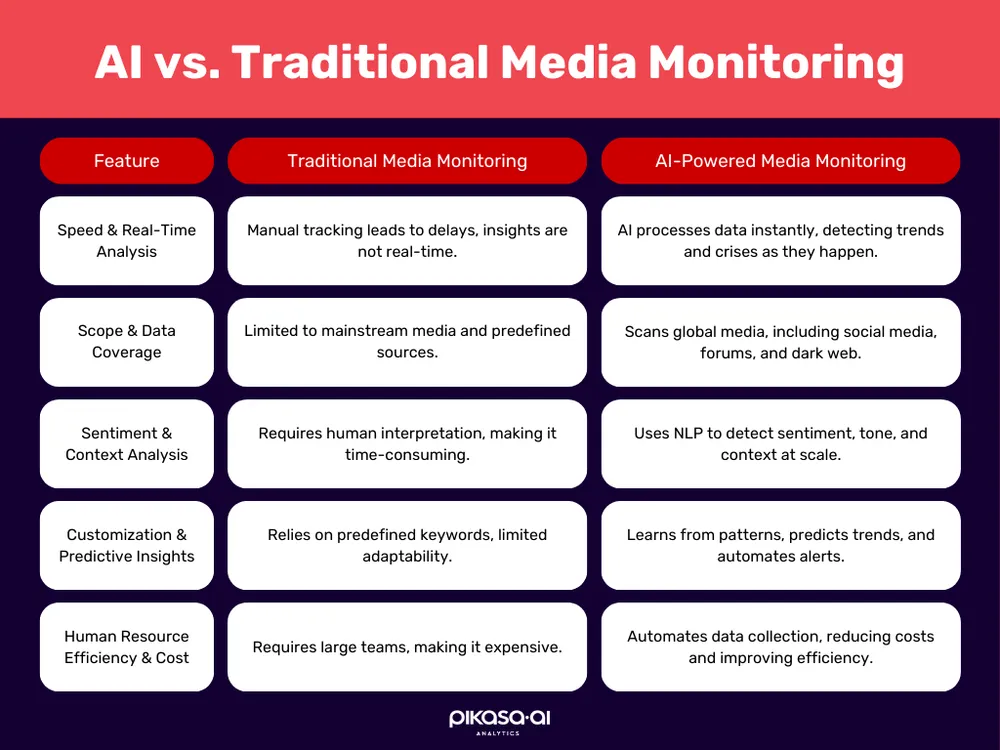The Evolution of Media Monitoring - How the AI helped instead of overtook this methodology of organization monitor?
What is Media Monitoring?
Media monitoring is the process of tracking conversations, sentiment, and emerging narratives across various media channels. Whether you are a corporate brand, think tank, media outlet, marketing agency, or PR agency, monitoring media allows you to stay informed about relevant topics, public perception, and potential crises.
Traditionally, this involved manual searches, keyword tracking, and human analysts compiling reports from newspapers, television, radio, and digital sources. However, with the rise of artificial intelligence, media monitoring has transformed into a faster, more precise, and scalable solution.
So, how exactly does AI-powered media monitoring differ from traditional methods? And which approach is more effective in today’s fast-moving digital landscape?
We have wrapped it all under one table, but if you have more time, you can analyze it in detail below:

1. Speed & Real-Time Analysis
-
Traditional Media Monitoring: Human analysts manually track sources, often resulting in delayed insights and limited real-time analysis.
-
AI-Powered Media Monitoring: AI-driven tools process vast amounts of data in real-time, instantly detecting breaking news, crisis signals, and trending topics.
Example: AI-powered platforms like Pikasa AI can identify potential PR crises as they unfold, enabling organizations to act swiftly rather than reacting after the fact.
2. Scope & Data Coverage
-
Traditional: Typically limited to mainstream media outlets, press clippings, and predefined sources.
-
AI-Powered: Scans global media, including online news, social media, forums, podcasts, and even dark web sources.
In today’s world, narratives don’t just form on traditional media channels. AI enables brands to track conversations beyond mainstream outlets, capturing a broader and more nuanced picture.
3. Sentiment & Context Analysis
-
Traditional: Requires manual interpretation, making sentiment analysis time-consuming and sometimes biased.
-
AI-Powered: Uses Natural Language Processing (NLP) to detect sentiment at scale, understanding sarcasm, regional dialects, and contextual nuances.
AI doesn’t just flag positive or negative mentions; it analyzes tone, intent, and emotional sentiment, making media insights far more actionable.
4. Customization & Predictive Insights
-
Traditional: Relies on predefined keyword lists and historical data, offering limited adaptability.
-
AI-Powered: Learns from new data patterns, offering predictive insights and automated alerts for emerging trends.
For instance, Pikasa AI’s adaptive learning models can forecast media trends and alert brands before issues escalate into crises—something traditional methods struggle to achieve.
5. Human Resource Efficiency & Cost
-
Traditional: Requires large teams of media analysts, making it resource-intensive and costly.
-
AI-Powered: Automates data collection and processing, significantly reducing costs while improving efficiency.
AI doesn’t replace human expertise—it enhances it by allowing analysts to focus on strategy rather than spending hours on data gathering.
Which Approach is Right for You?
While traditional media monitoring still has a place in certain industries, AI-powered tools clearly offer a competitive edge in speed, accuracy, and scalability. Organizations that rely solely on manual methods risk missing critical insights and reacting too late.
For those seeking real-time media intelligence, predictive analytics, and comprehensive coverage across all digital channels, AI-driven media monitoring is the future.
Want to see how AI-powered media monitoring can revolutionize your strategy? Explore Pikasa AI’s capabilities today.
Written by
Hristina Kolova
March 18, 2025